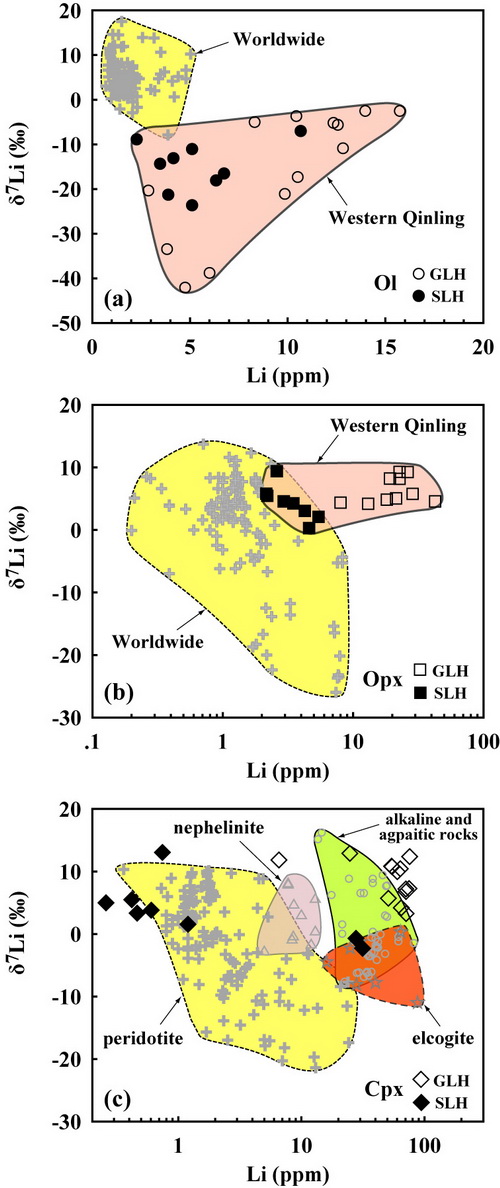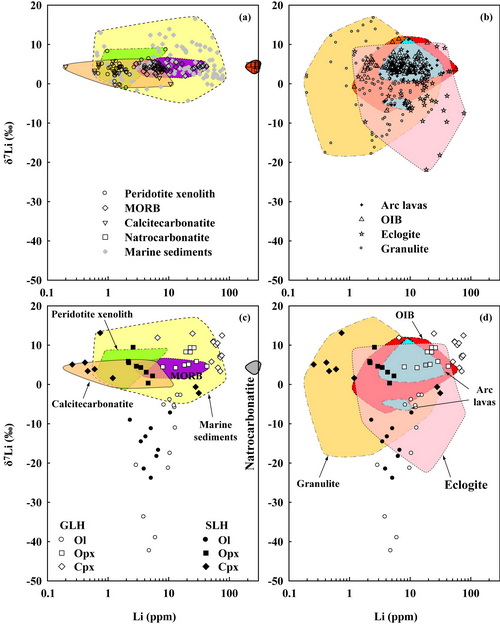Extremely high Li and low δ7Li signatures in the lithospheric mantleUpdate time:05 16, 2012
Postdoctor SU Benxun and his teacher ZHANG Hongfu present the first Li isotopic data on variably metasomatized peridotite xenoliths from the Qinling Orogenic Belt, which is a tectonic suture between North China and Yangtze Cratons following the subduction of the Tethyan Ocean in Paleozoic. They use these data to postulate a possible occurrence of high Li but low δ7Li mantle reservoir and explain the behavior of Li during peridotite-melt interaction. This study reveals the distinctive behavior of Li between the carbonatite and silicate metasomatism in the mantle.
Fig. 1. Li content vs. Li isotope in minerals of the Western Qinling periodititic xenoliths compared to worldwide data.(Image by SU)
Fig. 2. Na2O vs. Li and δ7Li diagrams (a, b, c, d) of orthopyroxenes and clinopyroxenes in the Western Qinling peridotitic xenoliths, showing positive correlation and metasomatic trend. Li elemental and isotopic variations (e, f) of Ol, Opx and Cpx in the garnet lherzolite and spinel lherzolite.(Image by SU)
Fig. 5. Li content vs. Li isotope illustrating compositional variations of the main Li reservoirs in the Earth.(Image by SU) Su et al. Extremely high Li and low δ7Li signatures in the lithospheric mantle. Chemical Geology. 2012, 292-293: 149-157 (Download Here)
|
Contact
Related Articles
Reference
|
-
SIMSSecondary Ion Mass Spectrometer Laboratory
-
MC-ICPMSMultiple-collector ICPMS Laboratory
-
EM & TEMElectron Microprobe and Transmission Electron Microscope Laboratory
-
SISolid Isotope Laboratory
-
StIStable Isotope Laboratory
-
RMPARock-Mineral Preparation and Analysis
-
AAH40Ar/39Ar & (U-Th)/He Laboratory
-
EMLElectron Microscopy Laboratory
-
USCLUranium Series Chronology Laboratory
-
SASeismic Array Laboratory
-
SEELaboratory of Space Environment Exploration Laboratory
-
PGPaleomagnetism and Geochronology Laboratory
-
BioMNSFrance-China Bio-mineralization and Nano-structure Laboratory

 Print
Print Close
Close


